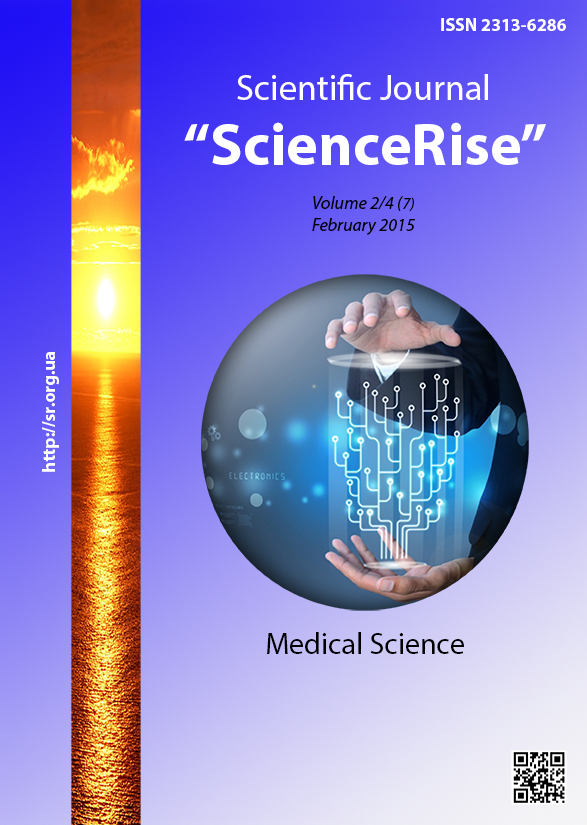Deliberate hypotension for spine surgery in prone position
DOI:
https://doi.org/10.15587/2313-8416.2015.38140Keywords:
spinal surgery, deliberate hypotension, urapidil, general anesthesia, hemodynamics, prone positionAbstract
Background. Deliberate hypotension during spinal surgery aims to reduce intraoperative bleeding, thus providing better surgical visualization and less requirements for transfusion. A lot of methods of controlled hypotension are used nowadays. Each of them has advantages and disadvantages.
The aim of study was to examine safety and efficacy of hypotensive drug urapidil for providing deliberate hypotension for spinal surgery in prone position.
Material and methods. Eighty patients were elected and divided into 2 groups. Patients of the 1st group (n=43) received urapidil for controlled hypotension intraoperatively and patients of the 2nd group did not receive hypotensive drugs intraoperatively. Hemodynamics, time of surgery and restoration of consciousness after general anesthesia (Bidway test 20 min after anesthesia).
Results. Patients in urapidil group had reduction of blood pressure to desirable level without any critical drops of hemodynamics comparing to the patients of 2nd group (p<0,05) whose blood pressure did not change significantly during surgery. Controlled hypotension allowed to reduce the surgery time comparing to patients without hypotension (p<0,05). Awaking time (Bidway test) did not differ significantly between groups. No anesthesia complications were found during examination.
Conclusion. Deliberate hypotension with urapidil is safe and effective during spinal surgery in prone position as it allows to provide good surgical visualization without adverse effects
References
Dongre, H. Sharma, V., Premendran, B., Dongre, A., Tidke, S. (2012). The efficacy of esmolol and nitroglycerine in creating dry operative field by producing controlled hypotension in spinal surgeries. IOSR Journal of Pharmacy, 2 (4), 26–33. doi: 10.9790/3013-24102633
Paul, J. E., Ling, E., Lalonde, C., Thabane, L. (2007). Deliberate hypotension in orthopedic surgery reduces blood loss and transfusion requirements: a meta-analysis of randomized controlled trials. Canadian Journal of Anesthesia, 54 (10), 799–810. doi: 10.1007/bf03021707
Lyzogub, M. V., Kostrikova, E. V., Khmyzov, A. O. (2013). Anesteziologichne zabezpechennja operatyvnych vtruchan u polozhenni na zhivoti [Anaesthesia in prone position]. Orthopaedics, Traumatology and Prosthetics, 3 (592), 99–106.
Postoperative Visual Loss Study Group (2012). Risk factors associated with ischemic optic neuropathy after spinal fusion surgery. Anesthesiology, 116 (1), 15–24.
Rodrigo, C. (1995). Induced hypotension during anesthesia with special reference to orthognatic surgery. Anesth Prog., 42 (2), 41–58.
Buch, J, Frederiksberg, C. (2010). Urapidil – antihypertensivnoye sredstvo s dvumja mechanismami deistvija: sovremennye aspecti klinicheskogo primenenija [Urapidil is antihypertensive drug with double action: modern aspects of clinical use]. Emergency Medicine, 5 (30), 5–14.
Dutton, R. (2004). Controlled hypotension for spinal surgery. European Spine Journal, 13 (S01), 66–71. doi: 10.1007/s00586-004-0756-7
Barrios, C., Pizá-Vallespir, G., Burgos, J., De Blas, G., Montes, E., Hevia, E., Collazos-Castro, J., Correa, C. (2014). Influence of hypotension and nerve root section on the ability to mobilize the spinal cord during spine surgery. An experimental study in a pig model. The Spine Journal, 14 (7), 1300-07. doi: 10.1016/j.spinee.2013.11.053
Downloads
Published
Issue
Section
License
Copyright (c) 2015 Микола Віталійович Лизогуб

This work is licensed under a Creative Commons Attribution 4.0 International License.
Our journal abides by the Creative Commons CC BY copyright rights and permissions for open access journals.
Authors, who are published in this journal, agree to the following conditions:
1. The authors reserve the right to authorship of the work and pass the first publication right of this work to the journal under the terms of a Creative Commons CC BY, which allows others to freely distribute the published research with the obligatory reference to the authors of the original work and the first publication of the work in this journal.
2. The authors have the right to conclude separate supplement agreements that relate to non-exclusive work distribution in the form in which it has been published by the journal (for example, to upload the work to the online storage of the journal or publish it as part of a monograph), provided that the reference to the first publication of the work in this journal is included.

